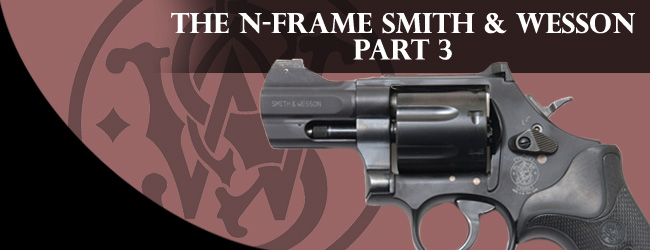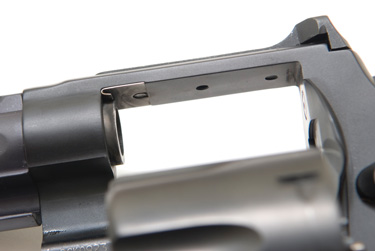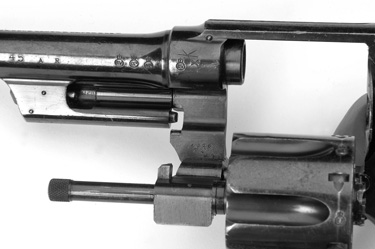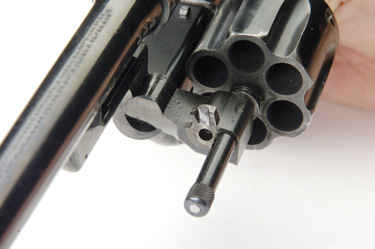
In the final installment of this series on the N-Frame Smith & Wesson revolver, the author takes a look at the .357 Highway Patrolman, .41 magnum, and other modern versions of the N-frame revolver.
Click here to read Part I
Click here to read Part II

In 1954, so as to satisfy demand for a more affordable magnum revolver, S&W introduced the .357 Highway Patrolman (in post-1957 nomenclature, the Model 28). While this N-frame lacked the external finish and cosmetic beauty of the .357 Magnum, its lower price made it an instant hit and it became one of the most popular American police handguns of its day. By the early 1960s the Model 27 and 28 were outselling the .38/44, .44 Special and .45 ACP caliber N-frame guns by a wide margin, leading to S&W quietly dropping them from their catalog.
By the early 1950s the renowned writer, shooter and hunter Elmer Keith had spent several years hot-rodding the .44 Special and was advocating the development of a revolver cartridge capable of taking big game. Between 1954 and 1955, in cooperation with Remington, S&W engineers developed the .44 Remington Magnum cartridge. This was based upon the .44 Special case lengthened 0.125 inch and loaded with a 240-gr. jacketed bullet that was pushed to 1180 fps for 741 ft/lbs. of muzzle energy, making it the hands-down, most powerful, smokeless powder revolver cartridge of all time.

Introduced in 1955, the massive S&W .44 Magnum Revolver (post-1957, the Model 29) was an expensive specialty item that sold in limited numbers to big game hunters. But with the release of Clint Eastwood’s hit 1971 film Dirty Harry, the Model 29 became the most sought-after handgun on the American market, causing prices to skyrocket as the limited numbers available quickly sold out.
While the pace of production at S&W’s factory was stepped up, it still took several years to catch up to demand. S&W’s marketing types wisely conducted an advertising campaign that used Dirty Harry movie posters to extol the virtues of their most powerful revolver. The Model 29 became so well know to the general public that even those persons who have no interest whatsoever in firearms can tell you in an instant what type of revolver Detective Harry Callahan carried!
“Magnum mania” was now sweeping the handgun world and it seemed that everyone with R&D or production facilities was either trying to develop a new magnum cartridge or market a revolver chambered for one. In 1963 S&W had announced a new N-frame, the Model 57, chambered for the .41 Remington Magnum cartridge, which was intended to provide sufficient power for hunting big game but with lower levels of recoil than the big .44.
The following year, in an attempt to popularize the .41 Magnum with police, S&W introduced the Model 58 revolver which, with its 4-inch heavy barrel and fixed sights, harked back to the .44 Hand Ejector Third Model. Despite the development of medium-velocity .41 Magnum loads, the concept never quite caught on with American police although a loyal group of big game hunters evolved that kept the .41 Magnum cartridge and Model 57 revolver commercially viable propositions.
The next trendsetting move by S&W occurred in 1963 with the introduction of the J-frame Model 60, the first all-stainless steel revolver. As the practicality – and popularity – of stainless steel grew, S&W expanded the option to most of their N-frame guns. Over the next several years, the market saw the introduction of the stainless steel Models 629 (.44 Magnum), 657 (.41 Magnum), 624 (.44 Special), 627 (.357 Magnum), 625 (.45 ACP) and 610 (10mm Auto). The two latter guns use full moon clips to handle the rimless pistol cartridges and, because of their rapid reloading capabilites, once dominated dominate those action shooting sports where revolvers are used such as ICORE, bowling pin shooting, IDPA and IPSC.
With the burgeoning popularity of semiauto pistols, in recent years the market for revolvers has shrunk, leading to S&W’s dropping several models. But that being said, over the past few years S&W’s Performance Center has introduced a number of limited edition and custom N-frame revolvers.
Six of the newest are the Model 625 5.25-inch competition revolver in .45 ACP; the classically styled, blue steel Model 251 .45 Hand Ejector in .45 Colt; the Model 28 in .357 Magnum (an eight-shooter, no less!); the Heritage Model 25-12, a reincarnation of the Model 1917 in .45 ACP; and two tricked-out hunting revolvers, the Model 647 Comped Hunter in .41 Magnum and Model 629 7.5-inch Stealth Hunter in .44 Magnum.

The newest kids on the block are the S&W Night Guard revolvers, which utilize a frame constructed from a special alloy that contains a small amount of Scandium, a rare metal that has the ability to transmit its strength and flexibility when alloyed with other metals – in the case of the Night Guard revolvers, aluminum. This allows the construction of lightweight frames capable of standing up to the operating pressures of magnum cartridges.
But the Night Guards differ from S&W’s other light weight revolvers in that a replaceable blast shield made of thin, hardened steel is positioned above the cylinder/barrel gap where it prevents hot powder gases from “cutting” the frame’s top strap. While it would have been possible to use titanium cylinders to reduce weight even further, S&W decided to fit the new revolvers with stainless steel cylinders featuring a Physical Vapor Deposit (PVD) matte black finish that provides increased protection against salts, solvents, powder residue, abrasion and just about any other problem they may encounter.
Night Guards also feature what just might be the most practical set of sights I have ever seen on revolvers intended for service use. The XS Sight Systems 24/7 Big Dot front sight has a tritium insert surrounded by a large, white ring making it equally visible in the dark or bright light conditions. The rear sight is a Cylinder & Slide Extreme Duty fixed unit whose generously-proportioned U notch allows a fast sight picture and alignment under a variety of light conditions.
The Night Guard line includes three N-frame guns: the M327NG (eight shot .357), M329NG (.44 Mag) and the M325NG (.45 ACP). As it would be unprofessional of me to pass judgement upon these handguns without actually test firing them, I amassed a varied selection of N-frame revolvers and my friend Butch Simpson and I ran them through their paces.
My test guns ran the gamut from oldest to newest: a British contract .455 Triple Lock (converted to .45 Auto Rim, and so marked on the left side of the barrel but restored by the present owner with an original .455 cylinder; a .357 Highway Patrolman; a .44 Magnum Model 29; and a Performance Center Model 625 5.25-incher. The intended purposes of these four handguns run the gamut from military service (Triple Lock*), to big game hunting (M29), to action pistol competition (M625) and, finally, to police service (Highway Patrolman). Test ammo consisted of the following: Federal .357 Magnum, 158-gr. Nyclad; PMC .44 Magnum, 180-gr. JHP;. Lawman .45 ACP, 230-gr. FMJ; and Fiocchi .455 Mk. II, 262-gr. LRN. Ably assisted by my good friend Butch Simpson, I fired each gun for accuracy from a rest at 50 feet.
While firing large caliber revolvers from a rest can be a trying process, our quartet of big Smiths proved controllable and accurate. As luck would have it, all four printed more or less to point of aim, even the fixed-sight Triple Lock. Neither of us was surprised when honors went to the finely made Performance Center Model 625, which put six rounds of Speer hardball into a pleasing 1-5/8-inch group.

Somewhat surprisingly, the runner-up was the heaviest recoiling of our test guns, the Model 29, with a beautifully centered 1-3/4-inch group. Even thought it had the shortest barrel, the Highway Patrolman was no slouch with a half dozen .357s in 2-1/8 inches, while the greybeard of the bunch, the Triple Lock, showed it could still do what was needed to be done with six Fiocchi .455s in 2-3/8 inches.
Butch then set up a series of D-1 target at ten yards and we performed the following drills with each revolver. As we did not have holsters suitable (i.e., big enough) for our test guns, each drill began with the shooter holding the revolver at the low ready position (45 degree angle to the ground). The test protocol was as follows:
1. Six rounds, slow aimed fire.
2. Three sets of rapid fire, double taps.
3. Six rounds as fast as we could obtain a flash sight picture.
We were gratified to find that all four of the N-frames performed these tasks with aplomb. In fact, except for a few hits in the outer scoring zones caused by the Triple Lock’s rather minuscule sights, all four of our targets had nicely centered groups in their respective X and 10 rings. Except for the differences in felt recoil the performances of these revolvers – each of which was produced in a different era, fired a different cartridge and was designed for a different purpose – were more or less equal.
Each displayed strong and weak features: the Triple Lock had an excellent DA trigger pull but its grips and sights were too small for fast shooting; the M29 was, once again, pleasingly accurate but its recoil was stiff; the Highway Patrolman was the handiest of the four although muzzle blast from the .357 cartridge was heavy; finally, while the M625 proved the most accurate, Butch and I both felt that replacing its smooth wooden grips with a set of modern, finger groove, synthetic grips would enhance handling even further.
In conclusion, I believe I’m safe in saying that the job description of the large frame, heavy caliber revolver has not changed all that much, if at all, in the last century. For this reason, a S&W N-frame wheelgun is sort of an ageless entity. In fact, it might be fair to say that a present-day law enforcement officer, soldier or outdoorsman would be equally well served with an 80-something year old S&W .44 Triple Lock as he or she would be with a modern M627 revolver.
Click here to read Part I
Click here to read Part II
Note: I would like to thank the following persons and organizations for supplying revolvers, ammunition, photos and much needed information used in the preparation for this article: Roy Jinks, Ken Jorgensen, Lois Chase, Vincent Scarlata, Butch Simpson, Bonnie Young, Daniel Hecht, Smith & Wesson, Inc., Fiocchi USA, PMC and Blount, Inc.
This article is an excerpt from the Gun Digest 2011 annual book.

Next Step: Get your FREE Printable Target Pack
Enhance your shooting precision with our 62 MOA Targets, perfect for rifles and handguns. Crafted in collaboration with Storm Tactical for accuracy and versatility.
Subscribe to the Gun Digest email newsletter and get your downloadable target pack sent straight to your inbox. Stay updated with the latest firearms info in the industry.








